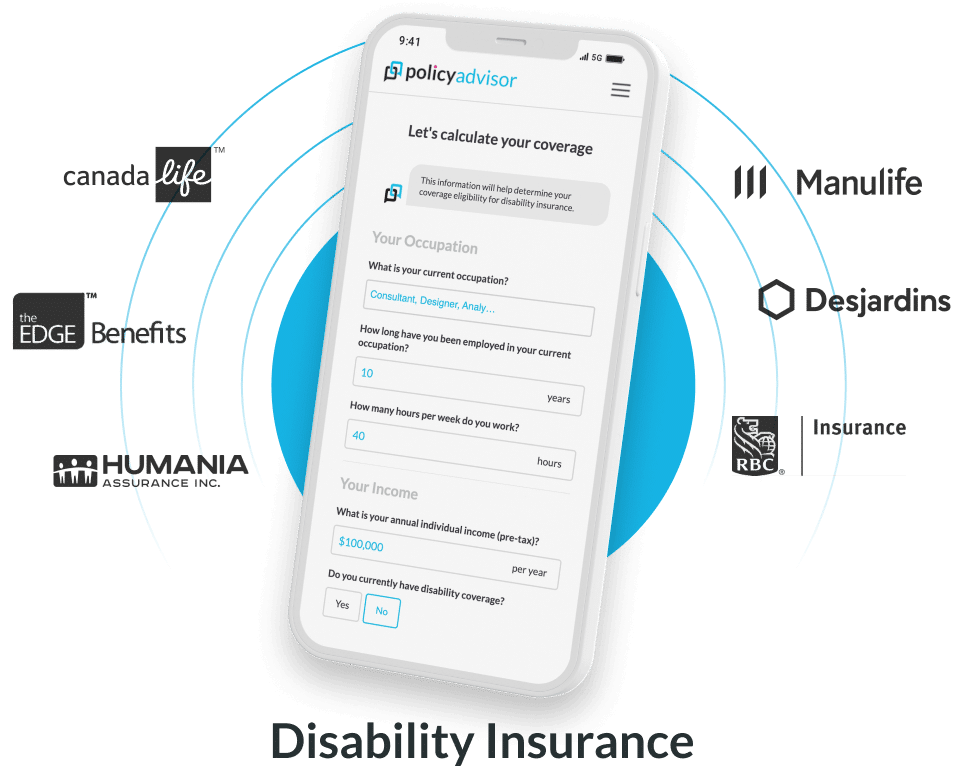- Short-term disability can provide income replacement when you cannot work due to injury or illness
- Benefit payments usually begin 1-14 days after you file a claim
- Benefit payments usually cover 50-100% of income
- Coverage typically lasts 6-26 weeks, but some policies may allow up to 52 depending on the case
- What is short-term disability insurance?
- How does short-term disability insurance work?
- How is an individual policy different from a work short-term disability plan?
- Is critical illness insurance the same as short-term disability insurance?
- What does short-term disability usually cover?
- Is it worth getting short-term disability insurance?
Disability insurance can protect you and your family from major loss of income if you’re injured or become ill and can no longer work. This insurance provides a monthly payout upon becoming disabled to replace some of the income you lose when you can’t work due to an illness or disability.
Coverage is categorized based on the length of the benefit period, called short-term disability insurance (STD) and long-term disability insurance (LTD).
In this article, we focus just on short-term disability insurance. We explain what it is, how it works, and what it covers. We further detail how it may differ from critical illness insurance and the differences between employer disability insurance and individual disability insurance.
What is short-term disability insurance?
Short-term disability insurance provides income replacement if you’re unable to work for a short period of time. The benefit payments can begin as soon as you use up your sick leave, sometimes as early as 1-14 days after a claim is submitted, with coverage lasting typically between 6-26 weeks – although coverage can also go as long as 52 weeks. It’s commonly used for temporary health issues, like minor accidents, sports injuries and back problems that may prevent you from working for a few weeks or months. The benefit payments from STD insurance can cover most of your lost income, so while you recover you don’t have to worry about meeting your basic financial needs.
You can get short-term disability insurance from three places:
- Federal programs: Employment Insurance (EI) usually accommodate Canadians who can’t earn an income due to a lay-off or shortage of work. However, EI also has specific qualifications in order to receive benefit payments. EI Sickness Benefits are also available for those who are injured or ill. This is paid out for a maximum of 15 weeks for 55% of your earnings with a max of $595 per week. For Canadians who cannot work on a regular basis due to disability, CPP Disability Benefits can help. This coverage pays out just over $1,413 a month max but is only available if the individual is completely unable to obtain gainful employment and has made adequate contributions to the CPP.
- Your employer: You may be eligible for short-term disability insurance through your work’s group insurance plan. This plan usually covers 50-100%% of your income and costs only a few dollars off your paycheck, although sometimes your employer may pay for the cost entirely.
- Individual plans: These are purchased on your own from a private insurance company, such as the ones we work with at PolicyAdvisor. Coverage goes with you anywhere and you decide how much you’re covered for, for how long, and how much you pay in premiums.
At PolicyAdvisor, we are happy to assist anyone looking to set up individual plans who do not qualify for an employer or federal short-term disability insurance. However, if you are eligible for employer benefits, they are usually the most cost-effective option for short-term disability—for long-term disability, it’s another story.
How does short-term disability insurance work?
Short-term disability insurance acts as income replacement for the time after you use your sick days and before any long-term disability insurance kicks in (if you have that in place). If you find that you are unable to work due to a disability, you may be able to take sick/leave days. When those sick/leave days are up or if you don’t have these types of days allotted to you through your work, you can file a claim through your short-term disability plan to make up for some of your lost income. In the claims process, the insurance company will usually require medical records and reports detailing your condition and disabilities due to the accident or illness. After you file a claim, benefit payments can begin almost immediately. The waiting period for benefit payments can sometimes be 1-14 days after filing in some cases. It’s important to note that the payment periods for an STD policy’s benefits may differ from your usual job payment schedule—benefit payments are usually monthly, not bi-weekly.
Coverage periods usually range from 6-26 weeks, although some policies allow for benefit periods of up to 52 weeks. Again, coverage varies between plans. If you can’t return to work after this period, you might need to transition to long-term disability benefits. The significant distinction between short- and long-term disability insurance is that a short-term policy usually considers a benefit period in weeks while a long-term disability policy counts a benefit period in years.
Regardless of whether it’s an individual or company policy, knowing what accidents, illnesses, and injuries your plan covers is essential. Every plan and insurer has different scopes. For example, disabilities resulting from mental health issues or pregnancy might not qualify for every insurance plan.
How is an individual policy different from a work short-term disability plan?
The most obvious difference between an individual and an employer’s short-term disability plan is who pays. If you purchase an individual plan from an insurer, you pay for it out of pocket. If you have a work plan, it may be your employer paying for it as part of your benefits package. Or, your work coverage might be a pooled effort between employees and taken off of your regular paycheck. Pooled plans may be offered by your union or through other agreements. Sometimes, you may have the option to upgrade your coverage in exchange for an additional deduction from your paycheque.
That being said, employer plans are cheap! Many short-term disability policies are offered through discounted group benefit plans, meaning that employees pay little to nothing in premiums—the premiums are usually deducted right off their paycheck. In general, however, the cost of an STD insurance policy is highly dependent on your salary. Because disability insurance pays out a portion (between 50% and 100%) of your income, premiums costs vary significantly.
If you are self-employed and don’t qualify for group or work short-term disability, then an individual plan is your best bet. While individual plans can be pricier compared to their group counterparts, you can customize your individual plan with one of the carriers we work with at PolicyAdvisor to fit your budget. For example, if you set your waiting period to 90-120 days, your premiums will be cheaper— but you will be responsible for replacing your income in that time before coverage kicks in.
Is critical illness insurance the same as short-term disability insurance?
Critical illness insurance is an agreement with a life insurance company where they pay you a tax-free lump sum in the event you contract a life-threatening condition or illness. Critical illness insurance and short-term disability insurance cover many of the same situations. For example, if a stroke hospitalizes you and prevents you from working, both benefits might kick in. However, a disability benefit is a monthly or biweekly payment to compensate for the loss of income, and critical illness insurance is a one-time lump sum payment.
Overall, disability insurance is meant to cover daily expenses and bills when you can’t work. Critical illness benefits fulfill the same need, but recipients also use the money to pay for costs such as private hospital rooms, medical expenses, and other recovery needs.
What does short-term disability usually cover?
Short-term disability insurance covers incidents when you can’t work due to injury, accident, or hospitalization. It doesn’t cover work-related or on-the-job injuries, as workers’ compensation usually handles this. The most common claims are for mental illness, musculoskeletal issues, injury, or poisoning
Examples of short-term disabilities that qualify for coverage
Suppose you get into a car accident while on a weekend getaway. You might end up in the hospital and require time off from your job as a construction worker. You might further need four months of at-home recovery to feel well enough to be back moving heavy materials on-site. During this time off, you won’t be able to receive your usual salary because you aren’t fit to work. Short-term disability insurance would instead step in to provide enough income to support your day-to-day needs.
Another example is if you faced a heart attack or stroke. Such an incident could trigger your short-term disability insurance and critical illness benefits. Again, your short-term disability plan could provide some or most of the pay you’re missing out on by not being able to work. If your recovery takes longer than your short-term benefit period, your long-term disability insurance may provide further coverage.
Does anxiety or mental health issues qualify for short-term disability?
While disabilities caused by mental health disorders are one of the top reasons for a disability claim, qualifications for anxiety or mental health issues depend on the insurer and the plan. With mental health issues becoming more diagnosed and recognized on the same level as a physical illness or injury, more insurers are including it in their short-term disability plans. However, not every policy guarantees mental health coverage — some might only cover physical injuries or require additional premiums to be included in the scope for mental health coverage or may exclude specific mental illnesses depending on the individual’s mental health history.
Whether mental health issues qualify may also depend on the severity. For example, if a panic attack hospitalizes you and you’re unable to work, it may better justify a short-term policy’s payout. In contrast, a stress leave may create a grey area to qualify for short-term disability insurers.
Is it worth getting short-term disability insurance?
Whether you should purchase short-term disability insurance depends on you and your family’s needs. First, figure out how much income you’ll need to replace if you face an unfortunate circumstance that leaves you unable to work. Could employment insurance payouts cover this amount? Or do you need additional coverage?
Further, your employer may sponsor short-term disability coverage. This might be a cheap option for you to cover some of your income, but it might not provide enough to fit your family’s needs. This might mean purchasing additional policies or upgrading your work plan.
It’s beneficial to work with an insurance advisor to determine what your short-term disability needs are and how much a short term disablity insurance policy costs. A member of the PolicyAdvisor can review your employer-provided plan and make sure you have a short-term disability policy that matches your needs. Schedule a call with one of our experts today and ensure your family is protected if you ever face an illness, accident, or injury.
Who sells disability insurance?
Many insurance companies also sell disability insurance products, and there’s one quick, simple marketplace that lets you compare them all.
Short-term disability insurance provides income replacement for when you cannot work due to an unexpected injury or illness. Some have this coverage through their workplace benefits that may cover 50-100% of income. Usually, short-term disability plans provide income replacement for 6-26 weeks but can cover up to 52 weeks before long-term coverage starts.


 1-888-601-9980
1-888-601-9980


